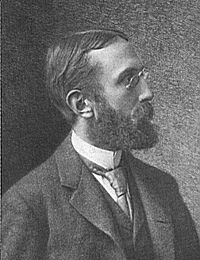Charles Eliot was a very accomplished apprentice of Frederick Law Olmsted. After touring Europe, at Olmsted’s suggestion, to view its most prized landscapes, he returned the the United States and opened his own practice. Olmsted had offered to take him into his firm, but Eliot declined. Olmsted on several other occasions repeated the suggestion, but without success. However, while the Olmsted firm was heavily involved in the design work for the grounds of the World Columbian Exposition in Chicago, key Olmsted partner Henry Codman died suddenly. Eliot accepted yet another overture to join with Olmsted and Olmsted’s step-son John as a full partner, the new firm being designated Olmsted, Olmsted and Eliot. Eliot helped complete the exposition project, and was the lead partner for the Boston metropolitan park system. Unfortunately, he also was stricken young, dying of spinal meningitis in 1897. Eliot was active with the Olmsted firm during much of its Buffalo involvement, although his role was lesser to that of the Olmsteds and Codman.

His obituary was published in Garden and Forest, Volume 10, Issue 475. [March 31, 1897], p. 130:
Charles Eliot, of the firm of Olmsted, Olmsted & Eliot, died suddenly at his home in Brookline, Massachusetts, on Thursday, the 25th of March, in the thirty-eighth year of his age. He was the son of President Eliot, of Harvard University, from which he graduated in I882, taking afterward a special horticultural course in the Bussey Institute to prepare himself for the profession of landscape-gardening. After traveling in Europe and studying the best examples of landscape-art in Great Britain and on the Continent he entered the office of Frederick Law Olmsted, with whose love of nature and artistic ideas he was in such full sympathy that he was soon entrusted with the design of works of considerable importance. At the conclusion of his studies he established himself in practice in Boston, where he achieved the success which a self-reliant, though unobtrusive, young man of original faculty and careful training had reason to expect. His greatest public service, however, at this period was the organization of the Board of Trustees for the preservation of beautiful and historic places in Massachusetts. If Mr. Eliot did not originate this idea, he was, at least, the most active promoter of the scheme which is bearing good fruit not only in Massachusetts, but has been adopted in other states, and promises to save from desecration and defacement many spots in different parts of the country which deserve protection for their beauty or patriotic association. Out of this idea grew the plan to save the natural charms of certain well-known places about Boston and unite them into a consistent system of public recreation-grounds, and Mr. Eliot took the lead in organizing the Metropolitan Park Board, of which he was made the landscape-architect. These magnificent pleasure-grounds and parkways, comprising thousands of acres of wooded hills and meadow-land, river stretches and sea views, were largely selected by him, and as they will be developed according to the plans he has outlined, they will make a monument on which an older artist might be content to rest his fame. Four years ago he became a member of the firm where he had received his training, and in a great variety of work he has proved himself one of the most accomplished of designers. He had an intense appreciation of nature, but he always kept up his student habits, examining the outdoor world critically, and reasoning upon what he saw to establish principles which could be applied in practice. He realized the relative importance of natural landscape and of architectural work; he planned with a broad spirit so that he could adapt his rules to buildings and gardens without any danger of over-elaboration on the one side or an affectation of naturalness on the other. He liked system, symmetry and dignity where artificial construction was needed, but no one appreciated better than he what was picturesque in nature, or had a greater reverence for her broad scenic aspects. Mr. Eliot was not only a man of creative faculty, he was, as the readers of this journal know, able to give reasons for the faith that was in him. He had the ability to make a. consistent and logical statement of his views and to express them clearly; but, beyond this, he had the gift of expression in a singularly effective style, so that some of his reports are as useful as his designs. The Metropolitan Park Report of i893, and others which have followed, together with his writings for the press, embody such an amount of sound doctrine, effectively stated, that one regrets that he has not left more of this kind of work behind him. In short, he was well equipped in every direction, and it is no exaggeration to say that his untimely death is an almost irreparable loss to rural art in America, a loss that will be felt more keenly since it follows so closely after that of Calvert Vaux, Henry Sargent Codman and Philip Codman.
Mr. Eliot was a man of the most delicate and refined; nature. He was reserved as scholars are, but his elevation of mind and dignity of character were apparent to all, and he had a gentleness of manner and thorough consideration for
the feelings of others which won the affectionate regard of all who were familiarly associated with him.